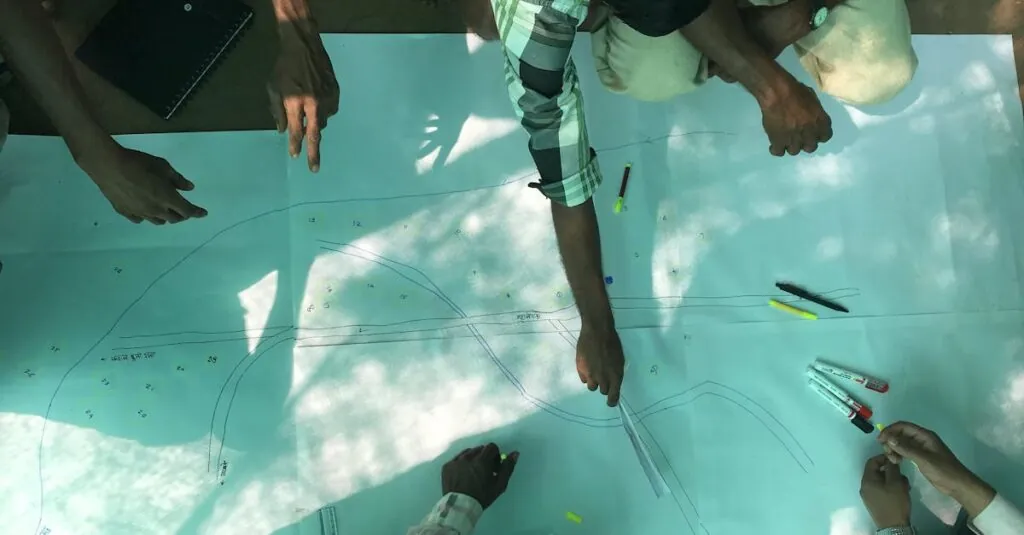In a world where infrastructure often feels like a game of Jenga, one wrong move could send the whole thing tumbling down. Enter the infrastructure rollback strategy—a clever approach to reassess and refine existing projects before they spiral into chaos. It’s like hitting the pause button on a movie where the plot’s gone off the rails, allowing decision-makers to regroup and reimagine a more sustainable future.
This strategy isn’t just about fixing what’s broken; it’s about ensuring that investments yield real value. With budgets tighter than a pair of skinny jeans after the holidays, stakeholders are realizing the importance of smart planning. So, whether you’re a city planner or a curious citizen, understanding this strategy could be the key to unlocking a brighter, more efficient tomorrow—without the risk of a mid-construction disaster.
Table of Contents
ToggleOverview of Infrastructure Rollback Strategy
Infrastructure rollback strategy focuses on reassessing ongoing projects to avoid complications. This approach allows decision-makers to pause and realign their goals and methodologies. Stakeholders benefit greatly from this process, which facilitates strategic planning geared toward efficient outcomes. A vital component involves identifying issues within the original project scope and applying corrective measures.
Additionally, the strategy emphasizes delivering tangible value from infrastructure investments. When budgets tighten, careful consideration of resource allocation ensures that funds are utilized effectively. Planners and citizens play significant roles in shaping these initiatives, as their feedback and involvement boost overall effectiveness.
Implementing this strategy requires robust data analysis and forecasting. Actions taken during rollback processes often involve incremental changes, thereby minimizing disruption. By using past project performance as a guide, stakeholders can prioritize essential upgrades while discarding less effective practices.
Collaboration among city planners, engineers, and community members strengthens this strategy’s impact. Ensuring public safety and infrastructure resilience forms the cornerstone of successful rollbacks. The ability to adapt and innovate in challenging economic periods underlines the necessity for practical solutions.
A thoughtful infrastructure rollback strategy provides a path forward for communities seeking to enhance their foundational systems. Employing this approach effectively cultivates transparency and adaptability in a rapidly changing environment.
Key Principles of Infrastructure Rollback Strategy
Infrastructure rollback strategy emphasizes adaptation and responsiveness to changing conditions. This approach prioritizes essential decision-making processes to safeguard community interests.
Importance of Flexibility
Flexibility represents a cornerstone of effective infrastructure rollback. Decision-makers must adjust strategies based on real-time data and community feedback. Adapting plans to new challenges creates opportunities for improvement and innovation. An agile approach allows stakeholders to navigate unforeseen obstacles seamlessly. Integrating flexible methodologies fosters resilience in infrastructure projects. Several successful projects demonstrate how adapting to change can enhance long-term sustainability.
Risk Mitigation Techniques
Risk mitigation techniques serve as essential tools within infrastructure rollback strategies. Identifying potential risks early can steer projects away from costly pitfalls. Implementing thorough risk assessments ensures a proactive stance toward potential challenges. Incorporating incremental changes reduces disruption while addressing underlying issues. Engaging diverse perspectives promotes a holistic approach to problem-solving. Utilizing data-driven forecasts enhances decision-making, ensuring stakeholders can act effectively. These techniques protect community safety and support infrastructure longevity, providing clear pathways to overcome adversity.
Implementation Steps
The implementation of an infrastructure rollback strategy involves careful assessment and execution to enhance project outcomes effectively. Stakeholders must consider several aspects throughout the process.
Assessment and Planning
Assessing the current project scope is crucial. This stage involves gathering data to identify existing issues. City planners should solicit feedback from the community. They can enhance the effectiveness of the project through collaborative discussions. Risk identification techniques also play an essential role. Analyzing potential impacts helps prioritize necessary actions. Deciding on acceptable compromises ensures that resources align with community needs. Building this consensus fosters a culture of transparency and adaptability in future projects.
Execution of Rollback
Executing the rollback requires meticulous coordination. Project teams must implement the identified changes incrementally to minimize disruptions. This approach ensures that necessary adjustments occur without causing significant delays. Collaboration between engineers and community members enhances trust. They can address concerns promptly during this phase. Utilizing real-time data allows for responsive decision-making. Monitoring the impacts of each change helps refine subsequent actions. Effective communication throughout the process keeps all stakeholders informed and engaged, reinforcing community involvement and support.
Case Studies
Case studies illustrate the effectiveness of the infrastructure rollback strategy in real-world applications, providing valuable insights into successful implementations and lessons learned from failures.
Successful Rollback Examples
City A faced significant budget constraints while attempting to improve its transportation network. Decision-makers utilized a rollback strategy, reassessing project scopes and engaging community input. By refining the original plans, they successfully allocated resources to high-priority areas, thereby enhancing public satisfaction. City B, grappling with aging infrastructure, applied similar tactics. The team reviewed past projects through data analysis and stakeholder feedback. This approach revealed critical issues, allowing them to implement cost-effective solutions that prioritized safety and operational efficiency.
Lessons Learned from Failures
Project teams live and learn during implementations. In City C, inadequate stakeholder engagement contributed to the failure of a critical water supply project. Community resistance stemmed from a lack of transparency in decision-making processes. Furthermore, City D encountered delays due to insufficient risk assessment methodologies. Without properly identifying potential risks, expensive overruns occurred and trust eroded. These cases highlight the necessity of integrating comprehensive community feedback and prioritizing risk mitigation strategies during project planning and execution.
The infrastructure rollback strategy emerges as a crucial tool for communities navigating the complexities of project management. By fostering collaboration and encouraging stakeholder engagement, this approach not only addresses existing challenges but also paves the way for sustainable improvements.
Emphasizing adaptability and real-time responsiveness ensures that decision-makers can effectively manage risks while optimizing resources. As cities face tightening budgets and evolving needs, the rollback strategy stands out as a proactive method to enhance infrastructure resilience.
Ultimately, the successful implementation of this strategy can lead to safer and more efficient systems that truly reflect the priorities of the communities they serve.










